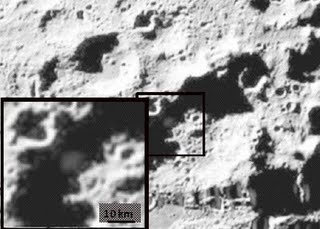Science Fiction
Dictionary
A B C D E F G H I J K L M N O P Q R S T U V W X Y Z
'Significant Amount' Of Lunar Water Found

A 'significant amount' of lunar water was found by NASA's LCROSS probe when it impacted a permanently-shadowed crater on the moon last month.
The water LCROSS detected "would be water you could drink, water like any other water," Colaprete said. "If you could clean it, it would be drinkable water."
The LCROSS probe impacted the lunar south pole at a crater called Cabeus on Oct. 9. The $79 million spacecraft, preceded by its Centaur rocket stage, hit the lunar surface in an effort to create a debris plume that could be analyzed by scientists for signs of water ice.
Those signs were visible in the data from spectrographic measurements (which measure light absorbed at different wavelengths, revealing different compounds) of the Centaur stage crater and the two-part debris plume the impact created. The signature of water was seen in both infrared and ultraviolet spectroscopic measurements.
"Indeed, yes, we found water. And we didn't find just a little bit, we found a significant amount," Anthony Colaprete, LCROSS project scientist and principal investigator from NASA's Ames Research Center at Moffett Field, Calif.

( LCROSS impacts in Cabeus crater on October 9th, 2009 )
The possibility of ice in the floors of polar lunar craters was first suggested by scientists in 1961 by Caltech researchers Kenneth Watson, Bruce C. Murray, and Harrison Brown.
Science fiction fans heard about the idea of lunar ice mining from Robert Heinlein in his 1966 novel The Moon is a Harsh Mistress:
One shy little fellow with bloodshot eyes of old-time drillman stood up. "I'm an ice miner," he said. "Learned by trade doing time for Warden like most of you. I've been on my own thirty years and done okay... I should say did do okay... because today you have to listen farther out or deeper down to find ice. "That's okay, still ice in The Rock and a miner expects to sound for it..."
(Read more about fictional lunar ice mining)
I should also add that sf readers were clued into the idea of using some sort of impactor to send up a cloud of particles for examination some years earlier. In his 1958 classic The Mechanical Monarch, E.C. Tubb used explosive missiles to determine the composition of asteroids:
Fire streaked in a thin line from the muzzle of a cannon-like tube mounted beneath the viewing instruments and a tiny, rocket-powered projectile, drove towards the mysterious bulk. It hit, exploding into a cloud of incandescent vapour, and Wendis stared thoughtfully at the brilliant lines on the spectroscope screen.
From Space.com.
Scroll down for more stories in the same category. (Story submitted 11/14/2009)
Follow this kind of news @Technovelgy.| Email | RSS | Blog It | Stumble | del.icio.us | Digg | Reddit |
Would
you like to contribute a story tip?
It's easy:
Get the URL of the story, and the related sf author, and add
it here.
Comment/Join discussion ( 0 )
Related News Stories - (" Space Tech ")
Will Space Stations Have Large Interior Spaces Again?
'They filed clumsily into the battleroom, like children in a swimming pool for the first time, clinging to the handholds along the side.' - Orson Scott Card, 1985.
Reflect Orbital Offers 'Sunlight on Demand' And Light Pollution
'I don't have to tell you about the seven two-mile-diameter orbital mirrors...'
Chrysalis Generation Ship to Alpha Centauri
'This was their world, their planet ó
this swift-traveling, yet seemingly moveless vessel.' - Nat Schachner, 1934
The First Space Warship For Space Force
'Each of the electrical ships carried about twenty men...' - Garrett P. Serviss, 1898.
Technovelgy (that's tech-novel-gee!) is devoted to the creative science inventions and ideas of sf authors. Look for the Invention Category that interests you, the Glossary, the Invention Timeline, or see what's New.
Science Fiction
Timeline
1600-1899
1900-1939
1940's 1950's
1960's 1970's
1980's 1990's
2000's 2010's
Current News
Golf Ball Test Robot Wears Them Out
"The robot solemnly hit a ball against the wall, picked it up and teed it, hit it again, over and again...'
Boring Company Vegas Loop Like Asimov Said
'There was a wall ahead... It was riddled with holes that were the mouths of tunnels.'
Rigid Metallic Clothing From Science Fiction To You
'...support the interior human structure against Jupiterís pull.'
Is The Seattle Ultrasonics C-200 A Heinlein Vibroblade?
'It ain't a vibroblade. It's steel. Messy.'
Roborock Saros Z70 Is A Robot Vacuum With An Arm
'Anything larger than a BB shot it picked up and placed in a tray...'
A Beautiful Visualization Of Compact Food
'The German chemists have discovered how to supply the needed elements in compact, undiluted form...'
Bone-Building Drug Evenity Approved
'Compounds devised by the biochemists for the rapid building of bone...'
Secret Kill Switch Found In Yutong Buses
'The car faltered as the external command came to brake...'
Inmotion Electric Unicycle In Combat
'It is about the size and shape of a kitchen stool, gyro-stabilized...'
Grok Scores Best In Psychological Tests
'Try to find out how he ticks...'
PaXini Supersensitive Robot Fingers
'My fingers are not that sensitive...'
Congress Considers Automatic Emergency Braking, One Hundred Years Too Late
'The greatest problem of all was the elimination of the human element of braking together with its inevitable time lag.'
The Desert Ship Sailed In Imagination
'Across the ancient sea floor a dozen tall, blue-sailed Martian sand ships floated, like blue smoke.'
The Zapata Air Scooter Would Be Great In A Science Fiction Story
'Betty's slapdash style.'
Thermostabilized Wet Meat Product (NASA Prototype)
There are no orbiting Michelin stars. Yet.
Could Crystal Batteries Generate Power For Centuries?
'Power could be compressed thus into an inch-square cube of what looked like blue-white ice'
